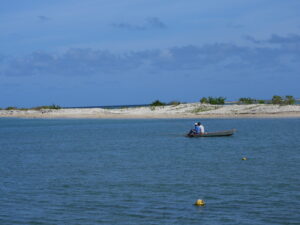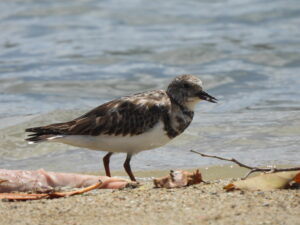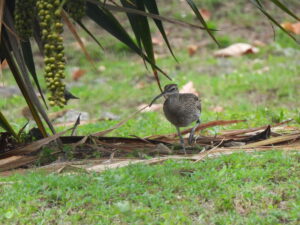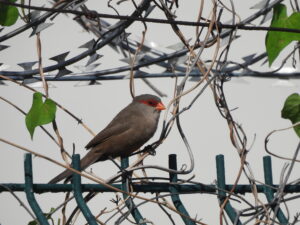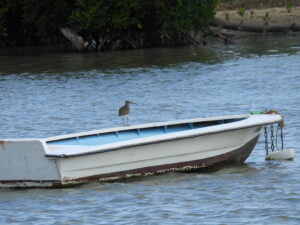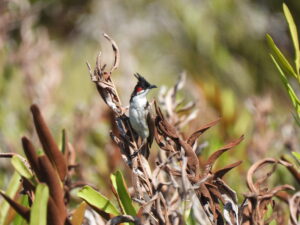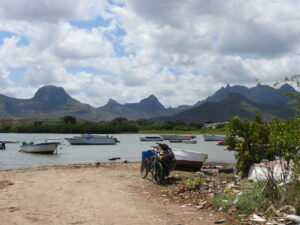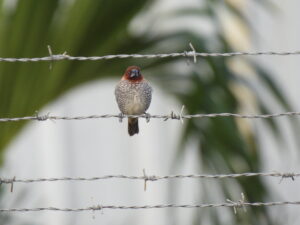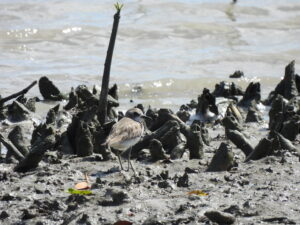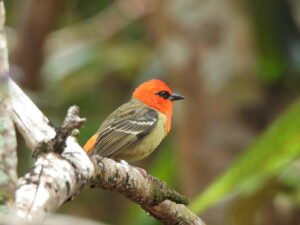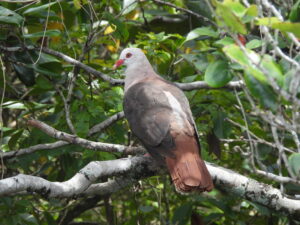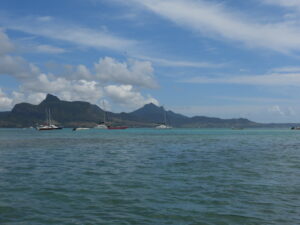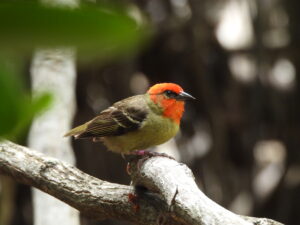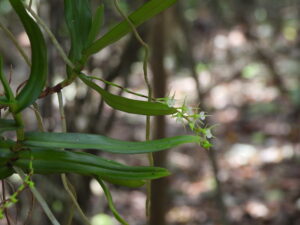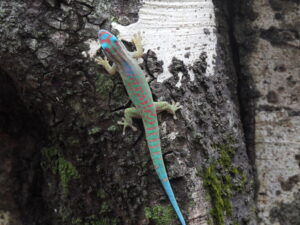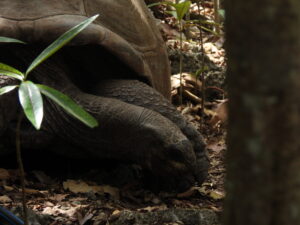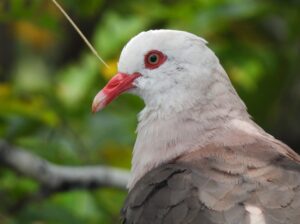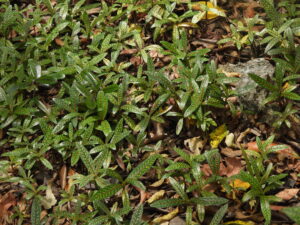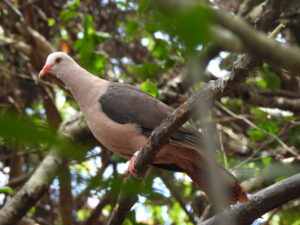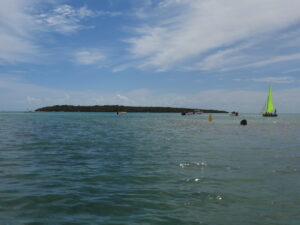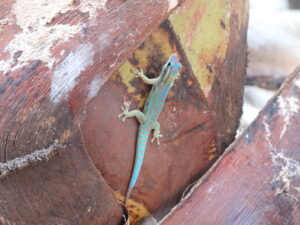Mauritius 2023
2 – 5 Nov 2023
Views of Flic-en-Flac, 3 Nov 2023
Day 1 Thursday 2nd November 2023
I landed in Sir Seewoosagur Ramgoolam International Airport in the afternoon on a delayed flight and the crew informed that the connecting flight to Madagascar was cancelled after all passengers to Mauritius departed. The night set as all passengers queued in the airport office, where we would be allocated to different accommodations and transfered. Despite the inconvenience, Turkish Airlines assumed all costs of shuttle service, accommodation and food until our departure from Mauritius on a flight relocation they arranged. I was not informed of the departure date for some days but staying less than 2-3 days on the island seemed unavoidable. While queueing, I connected to the airport wifi to catch up with peers and look for sights and top birding sites without going out of my budget.
Some hours later, I left the place on an airport van towards Port Louis, the capital of the country. Already at night, I only spotted several common mynas at the airport entrance area. Surprisingly, Turkish Airlines allocated me to a top-quality room in Labourdonnais Waterfront Hotel, a high-end accommodation far from my budget and plans. I enjoyed fine dinner on arrival and left to sleep as early as I could.
Day 2 Friday 3rd November 2023
The faint light through the curtains made me wake up at around 05.15 (two hours less in Helsinki time). The views from the balcony were great: Port Louis waterfront surrounded by the Indian Ocean under the sunrise colors. All of a sudden, a massive creature flies over the area: a Mauritius flying-fox. I could not believe my eyes, as I did not know one could see them from town. I had about 40 minutes before breakfast time started, so I quickly set off and walked out to the street.
Views from my room in Labourdonnais Waterfront Hotel, 3 Nov 2023
Waterfront of Port Louis
A former fossil coral islet now integrated in the center of Port Louis as the main shopping development of the country. Hotels, restaurants, international stores and casinos can be found here. Garden vegetation is home to a number of introduced bird species, while native waterbirds can be looked for at canals and under bridges (see here).
The parking area in front of Labourdonnais was empty of people at that time in the morning. Under some hedges, tens of house sparrows and zebra doves fed on seeds. The songs of abundant red-whiskered bulbuls and red fodies filled the space.
Further away, I saw some more wary doves, also introduced — spotted dove and Malagasy turtle dove, both introduced. At a certain point a house crow flew over some buildings in front of the waterfront. As I walked into town, a Ficus tree held a flock of scaly-breasted munia.
Few native species were also spotted. A whimbrel flew over the waterfront and into the buildings towards Port Louis, to my surprise. Walking around the canals and ditches, a striated heron was carefully watching for preys to fish, allowing me to observe several unsuccessful attempts. The highlight in the area was a white-tailed tropicbird crossing the waterfront over the sky — the only one seen during the whole stay in the country.
While I had not seen more Mauritius flying-foxes on the direction of the first one — rather facing at the ocean —, I soon noticed tens of these day-flying megabats flew over the city and into the volcanic escarpments of the island in different directions, likely setting off from their night roosts.
I had a dreamy breakfast at 06:00 in the hotel restaurant terrace overlooking the sea and quickly set off for a morning walk towards a wetland in Port Louis. The area was not empty anymore, as taxis filled the parking waiting for customers to go to the beach. I intended to reach the area walking and explore the city on the way, but hopes were low as there is very little information about the spot on the internet — indeed, it looks like it’s closed.
I must first say I felt safe in all places I visited throughout the country, despite being alone and having no SIM card on the phone or cash. Plus, being in Port Louis, I also thought I could always turn back if I ever felt uneasy. But I found hundreds of people walking the main road of Port Louis in both directions, commuting to work and wearing all different kinds of outfits. Something shocking I experienced was waiting for traffic policemen in rampant traffic in peak hour to give us way to cross the street after some 25 minutes of waiting, only once us pedestrians did not fit in the sidewalk anymore.
Getting to Rivulet Terre Rouge Estuary Bird Sanctuary (RTREBS) was an experience on itself and I hope there was an easier way to reach it. I tried several routes but there only seemed to be one way on my visit, so I provide some useful points on the map above to ensure reaching the wetland where the fence ends close to the ocean — no trespassing, just bordering. First, I entered the harbor area on a diversion to the left and bordered a stream. Over this spot I saw several Mascarene swiftlets. Then I continued north through the Port W Access road and cross a river. I turned left and walked the main road northwest — note that the checkpoints only stop cars, not pedestrians. House crows were quite evident in the area. Once in the large roundabout, turn left again towards Port Louis to enter a neighborhood once the fencing ends. The area is quite picturesque with colorful houses and coconut trees but I must admit I felt all eyes on me as locals are probably no used to tourists walking their streets. I walked the outermost road of the neighborhood past a football field and turned left to connect with the dirt road towards the ocean. The vegetation of the diversion point was full of butterflies and two gray francolins could also be seen. A rather long up north next to the fence bordering the mangrove already produced some great birds.
Bird hide by Rivulet Terre Rouge, 3 Nov 2023
Rivulet Terre Rouge Estuary Bird Sanctuary
Mangrove forest in the mouth of a stream within metropolitan Port Louis. Ramsar site wetland that hosts tens of migrant waders over boreal winter. While hard to reach, it seems the main point of the country to connect with them (see here).
The dirt road is fenced on both sides. As it diverts from the neighborhood, a quick turn left was the spot where a flock of common waxbills and couples of scaly-breasted munia and yellow-fronted canary were seen — both introduced. Walking the road towards the Ocean provided some vegetation clearings from which the mudflats could be seen at distance. Good numbers of gray plovers and whimbrels ran back and forth. Before I knew I would be able to get to the other side of the fence with RTREBS, I made sure I connected with all the waders I could from afar. Common sandpiper, greater sand plovers and Terek sandpipers also foraged in the mud and mangrove beaches — the two latest, exciting lifers.
Close to the end of the road, the fence finally ends. At that point, the scene is spectacular as the Indian Ocean features gorgeous shades of electric blue. Motorbikes passing back and forth while I walked the road belonged to fishermen and locals visiting a small church. Around the church, a couple of house crows behaved inquisitively. I approached the river mouth to enjoy the views, despite the shore was full of litter. Flocks of sanderlings and ruddy turnstones and some whimbrels were seen at very close range. On the other side of the river, a small group of curlew sandpipers foraged in the mud. I then walked down again, but this time on the other side of the fence, for closer looks of the birds.
The birds obliged. I made it through the mangroves to a bird hide that was closed. The platform however allowed me to approach the birds without disturbing them. Good numbers of gray plovers, whimbrels and greater sand plovers probed the mud for preys — perhaps feeding on the thousands of fiddler crabs of the area. After some waiting, a Terek sandpiper showed up again and gave great views for a while. Once satisfied, I started the walk back as the temperature rose. On the fence between RTREBS and the dirt road, a tiny warbler-like bird sitting on the creeping vines turned out to be a Mauritius gray white-eye, a bird I did not expect to see on this part of the island.
I arrived to Labourdonnais about an hour later. After working and having lunch, I left again for an afternoon excursion. I withdrew some Mauritian rupees from an ATM and walked down to Victoria bus station to catch a bus to Flic-en-Flac. From Port Louis, the route number 123 costs 15 MUR (0.30 EUR) per passenger and journey to its last stop ‘Wolmar’ in the southern beaches of Flic-en-Flac.
Beach resort in Flic-en-Flac, 3 Nov 2023
Flic-en-Flac
Top tourism destination in the west coast of Mauritius full of resorts and options for leisure activities. White sand beaches, some open for a dip, and coconut tree and Casuarina tree groves all around (see here).
I visited Flic-en-Flac hoping I could get a glimpse of the marine life of the island. However, the tide was at its highest point and the visibility was quite bad. I still enjoyed the dip but saw no more than four fish. Few people were around — all tourists — and no one was in the water besides a few people in a fenced beach (protecting for sharks?) so I decided to get dry and walk south.
The sand was full of ghost crabs which ran to their burrows once I walked too close. I noticed several Mauritius gray white-eyes on the palm trees, but this is a more classic area for the species and it seems to be quite abundant. As I walked through the gardens of different resorts (which are just open at the beach), I noticed many common mynas and zebra doves feeding on the lawn. Several confiding Mascarene martins sat on top of umbrellas, dipped on the infinite pools and displayed close-range flights on a resort. Among the palm trees I spotted numerous Oriental garden lizards. The Pandanus trees bore several tiny blue-tailed day geckos, endemic to Mauritius. The views, once again, were awesome as the shape of Le Morne appeared at the end of the beach over beautiful blue hues.
I walked back to Wolmar area where I dropped off the bus and kept walking north through a vibrant set of beach stalls. A mixed flock of village weavers and red fodies fed on the ground and a Mascarene swiftlet flew over closeby. I caught one of the last buses of the day (check out the schedule!) and the drive back was quite scenic. Halfway, a police station had a big tree next to it where tens of Mauritius flying-foxes gathered.
When I got back to the hotel I called it a day and just strolled around the waterfront and commercial area of Port Louis at night afterwards. I got the news that my departure from Mauritius had been rescheduled on Sunday 5th midday, which meant I would have the entire Saturday to explore the island.
Day 3 Saturday 4th November 2023
I had an early breakfast again while I browsed the internet about how to get to the south end of the island — Mahébourg. I was a bit confused about the departure terminal (Deschartres St) and committed the mistake to ask at the hotel reception, where the staff did not hesitate to ask for an extremely overpriced taxi (400 MUR, approximately 8 EUR) for a walkable distance of 5 minutes — I provide the location on the Port Louis map, but I recommend to ask around once on a bus station. The route number 198 covers Port Louis to Mahébourg via the airport and costs 80 MUR (some 1.60 EUR).
Leaving Port Louis at peak hour around 06:30, I arrived to Mahébourg around 08:45. I got dropped off at Mahébourg waterfront, where a blue bus with sea turtles painted on it serves as a shuttle through Blue Bay. My patience was tested as the bus showed no signs of operating for a good half an hour. Meanwhile, I observed village weavers flying back and forth some palm trees where their distinctive nests hung. Hopefully, at some point a driver showed up and I got to Pointe Jerome (for 10 MUR or 0.20 EUR, I believe).
Pointe Jerome is the place where the visitors center for Île-aux-Aigrettes sits. I was afraid as I thought I might need a pre-booked spot on the boats visiting the island reserve and I knew for a fact that the shuttle bus arrived later than the last morning visit slot. However, once on the spot I realized things were quite flexible. Me and several other tourists arriving last minute paid for our entrance fee (22 EUR, card accepted) and got transferred to a speedboat.
Panorama of Île-aux-Aigrettes before arrival, 4 Nov 2023
Île-aux-Aigrettes Nature Reserve
Island off Blue Bay south of Mauritius which holds the last remnants of dry coastal forest, including tens of endemic species of plants no longer found on the main island. Endemic reptiles and birds have been released as a reservoir for their populations, including pink pigeon, Mauritius olive white-eye and Mauritius fody (see here).
The speedboat ride takes place over the clearest waters I had ever seen, where ‘islands’ of coral reef full of colorful fish could be seen from the surface. Île-aux-Aigrettes is a flat island quite close to the shore. Soon enough we are dropped in a small harbor and the first two birds to show up in the trees around the boat were a brilliant couple Mauritius fody, one of the three stars of the island. The visit consists on a guided tour through different points of the island where Mauritian Wildlife Foundation takes action and introducing us tourists to some of the main plant species still present on Île-aux-Aigrettes.
A great tour stop was the visit to the tortoise nursery, where Aldabra giant tortoises clutches are cared for and raised. These tortoises have been introduced to the island to mimic the ecological niche that extinct giant tortoises in Mauritius covered, which seemed to be fundamental for the configuration of the dry coastal forest ecosystem. As the extinction of giant tortoises might have been a big reason causing the eventual disappearance of this forest in the main island, the presence of these giant tortoises at Île-aux-Aigrettes aims at preserving the remnants of this ancient ecosystem with reduced further human intervention. On a side note, I believe Aldabra giant tortoises are the highlight for the general tourist!
We also visited the plant nursery, where numerous seedlings of endemic species were being cared for before being planted across the island. There are several rare ebony trees chopped off for fine wood characterizing the vegetation of this forest, including a species now only restricted to the island, Diospyros egrettarum. Other shown plants include the endemic and critically endangered bottle palm Hyophorbe lageunicaulis widely used in gardens but here in the wild, the Mascarene-endemic Coptosperma borbonicum whose juvenile (heteroblastic) leaves show a spotted pattern as an adaptation against tortoise herbivory, the beautiful orchid Oeoniella polystachus found here and somehow also in Madagascar and Seychelles. Throughout the island but most especially in the nursery, numerous Mauritius blue ornate day geckos were seen, although not necessarily associated to the endemic Pandanus vandermeeschii.
Another stop in the middle of the forest featured real-size sculptures of all the extinct species of Mauritius. A sad story of our impact as humans on extremely sensitive island ecosystems. Besides the giant tortoises, Mauritius has seen the extinction of tens of once widespread species. Only among birds on the main island 11 species were lost, including a wood pigeon, a blue pigeon, a turtle dove, a duck, a shelduck, a night-heron, an owl, a gray parrot, the broad-billed parrot, the red rail and the charismatic dodo. Ironically (and perhaps even more sad), the dodo has now become a symbol, some sort of unofficial mascot widely used not only in Mauritius, but also in Réunion — as I could see on my visit some years ago despite never being present there.
There is a bird feeding station in the middle of the island. Besides several beautiful Mauritius fodies (beware that red fody is present and abundant on the island!), a pink pigeon came into view. Hearing about how close the species had been to meet the fate of the dodo, one gets goosebumps when seeing these large pale forest pigeons. Birds are quite used to the presence of people on the area and several pink pigeons obliged throughout our walk around the feeding station, allowing close-up views.
I am pleased to see the results of decades of conservation efforts while visiting the island. This experience has served as food for thought about what saving all of this takes. I am happy to contribute to all the actions carried out on the island with a reasonable fee and reduce the stress over the forest by walking a pre-established path. Despite the office can arrange tailor tours, the general visit allows little room to personal agendas and I felt that my guide was somewhat tired of birdwatchers when I asked about the third star of the show, the Mauritius olive white-eye. We never got to see this species, nor the cryptic Round Island ground skink and Round Island day gecko. But the interesting landscape and the awesome views of different species made up for it.
The way home was rather uneventful and I reached Labourdonnais for late lunch. I saved the binoculars and allocated the afternoon to explore Port Louis by foot and prepare for the final leg of my journey towards Madagascar.
Day 4 Sunday 5th November 2023
Another early start for the last morning in Mauritius. I left Labourdonnais at 06:00 towards the city to explore an urban park quickly before breakfast. Although I never felt unsafe in Mauritius, the only time in which I felt slightly uncomfortable during the trip was entering the park at this time of the day as drug addicts were the only people around. I backed up for breakfast and went back to the area past 07:30, once the city was vibrant again.
Vegetation of the park, 5 Nov 2023
Les Jardins de la Compagnie
Urban park in Port Louis city center, formerly used as a smallpox cemetery and a vegetable patch for the French East India Company back during the French occupation period. Today, large banyan trees are home to a large colony of Mauritius flying-foxes (see here).
Walking Les Jardins de la Compagnie is an experience on itself as the different sculptures provide an idea of the historical importance of the park. Besides, the thickness of banyan trees cast a dark shadow and the area is full of prop roots as columns flanking the whole garden. The few introduced birds seen had by then become usual sights in Port Louis and across the island, highlighting village weavers nesting in some trees.
The highlight of the park are the tens of large Mauritius flying-foxes hanging from the trees and flying over the garden and buildings around. Their display of heavy flights are an aerial show I enjoy for over an hour.
Later, I head to Labourdonnais to pack up and get ready for my transfer to the airport, from where I would finally leave to Antananarivo after lunchtime. Starting to be aware of all the wonders Mauritius still holds, I managed to connect with 29 different bird species, including three Mauritius endemics and two Mascarene endemics and other long expected targets among the wader species seen. Pleased to have discovered these landscapes and species on a budget and during a short visit, I write this report in hopes the indications can prove useful for readers visiting the island.

